Listen to This Article:
Have you ever watched a cake decorating show and been in awe of the chefs’ ability to make the cakes come to life?
From simple piped flowers to elaborate fondant work, each piece is carefully crafted for the theme, event, or occasion. You know that cake decorating is more than simply spreading icing on a cake—it’s your chance to add an artistic touch to a delicious dessert.
So, whether you create seven-tier cake masterpieces or just want to make cupcakes for your kiddos, these seven basic cake decorating techniques will help you make your cake designs come to life.
Before You Start: The Tools and Equipment Needed to Decorate a Cake
Before you can try the different cake decorating techniques, you’ll need the right tools and equipment at your disposal.
Using the right tools can help make the decorating process smoother and more enjoyable, as well as more efficient when working as a pastry chef in a fast-paced professional kitchen. Having a well-stocked toolbox is an important part of the foundation of creating a visually appealing cake.
Essential Cake Decorating Tools
- Pastry Spatula: Used for applying icing smoothly or creating textured finishes.
- Piping Bags: Come in various sizes and are used to hold and dispense frosting as you pipe.
- Piping Tips: Come in various shapes, such as star, round, and petal.
- Fondant Smoother: Helps achieve a seamless, crack-free fondant finish.
- Airbrush Kit: For adding color and intricate designs with smooth gradients.
- Rolling Pin: Essential for rolling out fondant to the desired thickness.
- Sugar Thermometer: Necessary for sugar work, ensuring precise temperature control.
- Turntable: A rotating cake stand for easier and more consistent decorating.
Regularly inspect your decorating tools for wear and tear. Replace any parts that are damaged or worn. Sharpen edges as needed and ensure any moving parts in airbrush machines are properly functioning. You don’t want to find out that one of your tools won’t work properly when you’re in the middle of decorating a cake.
With these essential tools at your disposal, you’re now ready to dive into the techniques that can help you elevate your cake decorating skills.
1. Spatula Icing
Just like a room requires a good coat of paint before its decor can shine, the first step to a beautiful cake is a flawless coat of icing.
While the pros make icing a cake look easy, you’ll need the proper tools and some practice to develop this technique. A pastry spatula is the easiest way to apply icing, no matter if you’re aiming for a smooth coating or textured finish.
Some designs to practice include smooth coatings, vertical lines, and the spatula painting technique shown below.
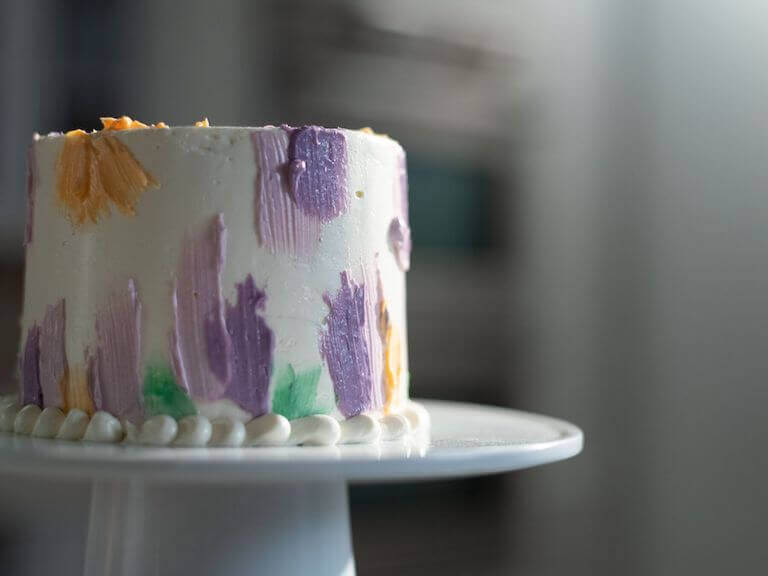
You can use different styles of the same spatula technique to create an original cake design.
2. Piping
If you work in cake decorating, you won’t be able to escape piping. Everything from elegant tiered wedding cakes to playful birthday sheet cakes rely on this classic technique.
Before you begin piping, you’ll need to fill a pastry bag with icing and choose the proper tip. Since piping tips come in a variety of shapes and sizes, make sure you pick the one that will allow you to complete your desired design.
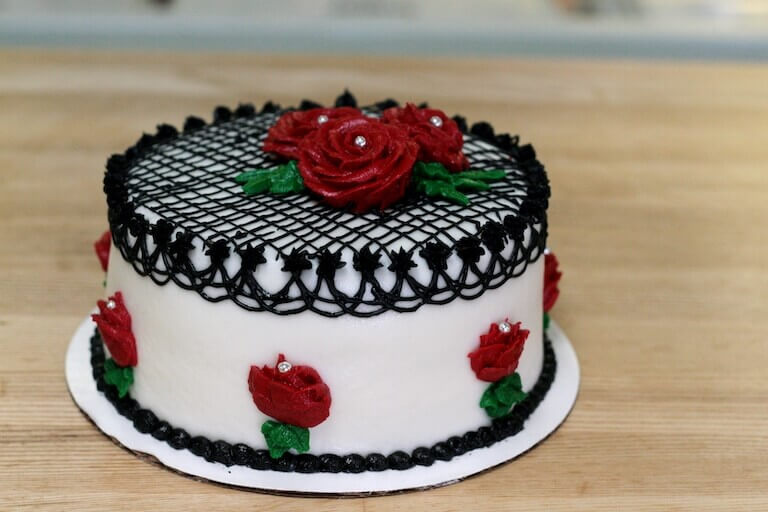
Multiple piping techniques including fine lines, roses, and stars.
While some cake decorators use their pastry bag like a paintbrush and let their creativity shine, there are some fundamental piping techniques most pastry chefs should have in their repertoire.
- Stars are made using a star tip and a single squeeze of the pastry bag. Use multi-colored stars as stand-alone decorations or combine them to create textured tops or borders.
- Dots are created much like stars but with a round rather than a star tip.
- Rosettes add a floral-inspired element with a limited amount of work.
- Shells are the foundation of one of the most popular cake borders, but they can also be used to cover a cake with a subtle texture.
- Zig-Zags are just like what they sound like. You can use them to create borders, cover sides, or fill in shapes.
3. Fondant Work
Fondant, a rollable icing, is another tool that should be in any cake decorator’s toolbox. Once you get the hang of working with this flexible yet stable material, you’ll be able to add new styles to your cake decorating skills.
Pastry arts professionals at the very least should practice covering a cake in fondant to create a smooth and elegant appearance. Once you’ve perfected covering a cake, you can then explore adding designs and texture to the fondant.
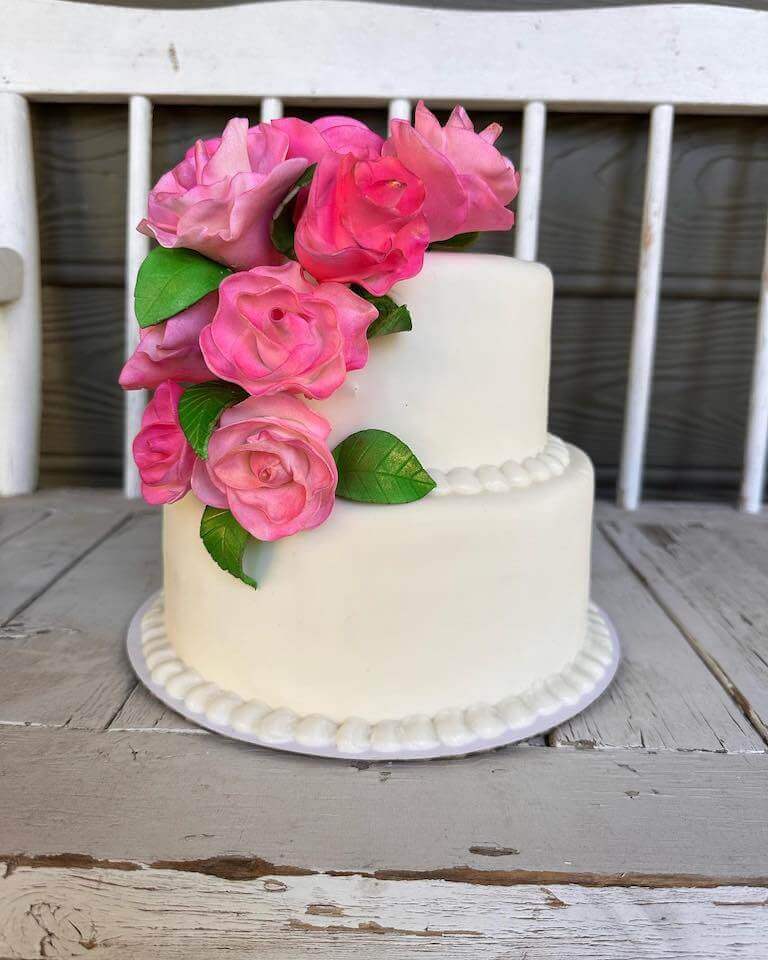
Two-tiered fondant cake with fondant and gum paste flowers by Online Baking & Pastry Arts Graduate Kali R.
Along with fully coating cakes, you should eventually be able to use fondant to create shapes and structures. These include everything from simple polka dots to intricate flowers. If you’re looking to create extravagant cakes such as those found on shows like Ace of Cakes and Cake Boss, continue to sharpen your fondant skills.
4. Hand Painting
Once you’re comfortable with fondant, it’s time to add some flair to your cakes with hand painting. As the term suggests, hand painting involves using edible pigments to paint designs on a fondant canvas. Decorators can use this technique to create simple shapes like dots and lines or complete scenes that rival the works of Vincent van Gogh.
This technique may involve freehanding a design or using a template or stencils to help guide your work.
*Information may not reflect every student’s experience. Results and outcomes may be based on several factors, such as geographical region or previous experience.
5. Sugar Work
While sugar work is a more advanced technique, it helps cake decorators stand out from the crowd.
Much like artists using molten glass to create bowls and sculptures, sugar work involves crafting melted sugar into exquisite shapes and forms. Once you become comfortable with this technique, you’ll be able to adorn cakes with sugary swirls and sweet sculptures.
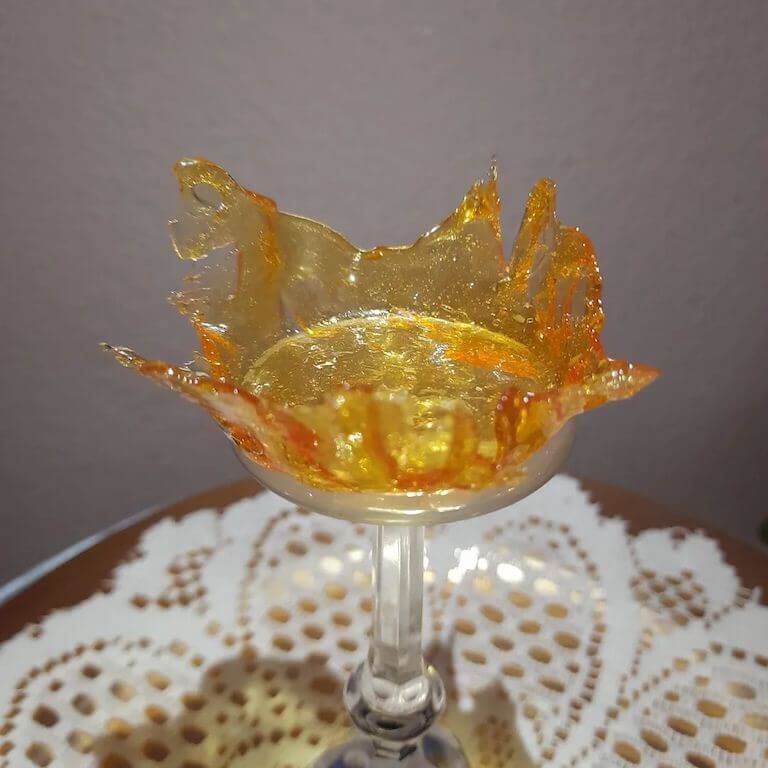
Sugar work by Escoffier Online Baking & Pastry Student Maria Christina D.
6. Airbrushing
Airbrushing uses an air gun similar to that used by car detailers and graffiti artists. But rather than working on rims and underpasses, pastry artists work on cakes.
This technique is similar to hand painting in that it allows you to add color to a cake after you’ve finished with your icing or fondant. However, airbrushing allows for quicker coverage as well as seamless blending of colors.
If you’re aiming for an ombre effect, airbrushing is the technique to use.
7. Mirror Glaze
If fondant and buttercream icing are the equivalent of matte paint, then a mirror glaze is akin to a high-gloss finish. This technique involves combining gelatin, sugar, and other ingredients until they reach the perfect temperature. At this point, the satiny mixture is poured over a chilled cake.
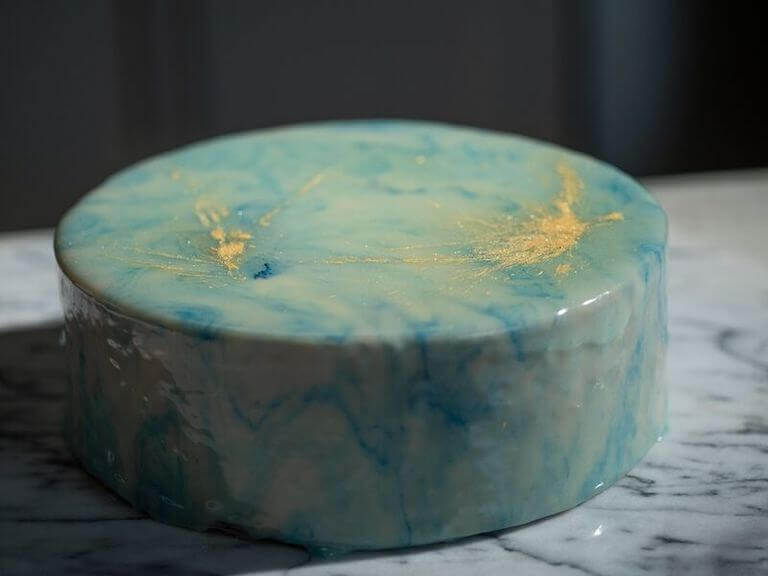
A mirror glaze can produce the marbled colors seen on the cake above as well as solid hues.
Common Cake Decorating Mistakes & How to Fix Them
Even with knowledge of the techniques and the right tools, mistakes can still happen. Here are some of the common mistakes pastry chefs and home bakers can run into as they decorate and what you can do to avoid making them yourself:
Cracked Fondant
To avoid cracks from the start ensure your fondant is properly kneaded and not too dry before applying. However, if you end up with cracks as you work, the following tips may be able to help you smooth them out:
- Use a fondant smoother or your clean, dry fingers to gently rub the cracked area. This can help blend out small cracks and imperfections
- Dip your finger in water to get it slightly wet and smooth it over the crack. The water can act as glue, helping to pull the fondant together.
- Cover the crack with decorations. If you can’t fix it, you may be able to hide it with other decorations to make it “disappear.”
- Re-knead the fondant with a small amount of shortening or glycerin to add moisture and help restore elasticity.
Uneven Icing
A level cake turntable and a steady hand can help apply icing evenly. However, if you find that your icing is uneven, you can try the following:
- Use an offset spatula or a bench scraper to level the icing. Hold the spatula or scraper at a slight angle and gently press it against the cake as you turn the turntable, smoothing out any uneven areas.
- Add a small amount of icing to low areas and smooth it out with your spatula or scraper.
- If necessary, chill the cake again after the first layer of icing has been smoothed. Once it’s firm, apply a final thin layer of icing to achieve an even, polished finish.
Airbrush Splotches
It’s helpful to always test your airbrush on a piece of parchment paper before applying it to the cake to check the pressure and consistency of the color. Try the following if you run into a problem with splotches:
- Immediately use a clean, soft brush to gently blend the edges of the splotch into the surrounding area. This helps diffuse the color and minimize the appearance of the splotch.
- Instead of applying a heavy coat of color all at once, use light, even strokes to build up the color gradually. This method reduces the risk of splotches and gives you better control over the final appearance.
- Consider incorporating a splotch into the design if it is noticeable and difficult to fix. You can add additional airbrushed elements, edible decorations, or piping to mask the imperfection.
Improve Your Cake Decorating Skills With a Pastry Arts Education
Maybe you’ve been baking cakes at home for years and are looking to turn your hobby into a career. Or maybe you’ve just realized that you can chase your dream of becoming a wedding cake designer. No matter the case, a formal education can provide you with the knowledge and skills you may need to follow your pastry passion.
By enrolling in Escoffier’s Baking & Pastry Arts program and taking cake decorating classes, not only can you learn how to seamlessly coat a cake with fondant and pipe a straight line, but you can also learn important baking and pastry fundamentals. This well-rounded education can provide you with the skills you may need to bake delicious and stable cakes that serve as canvases for creative design work.
Pastry school also provides you the opportunity to practice new skills and make mistakes in a relatively low-stakes environment. And every student at Escoffier undertakes an industry externship, where they may have the opportunity to put those skills to the test in a professional setting. Take the first step to building your pastry arts skills, and talk to us about how a degree or diploma program could be the best next step for you.
OTHER BAKING AND PASTRY ARTICLES YOU MAY WANT TO CHECK OUT NEXT:
- What are the Baking and Pastry Arts…and is it a Career for You?
- How to Become a Pastry Chef
- 6 Skills That Every Baker Should Have
*Information may not reflect every student’s experience. Results and outcomes may be based on several factors, such as geographical region or previous experience.
This article was originally published on February 7, 2022 and has since been updated.


